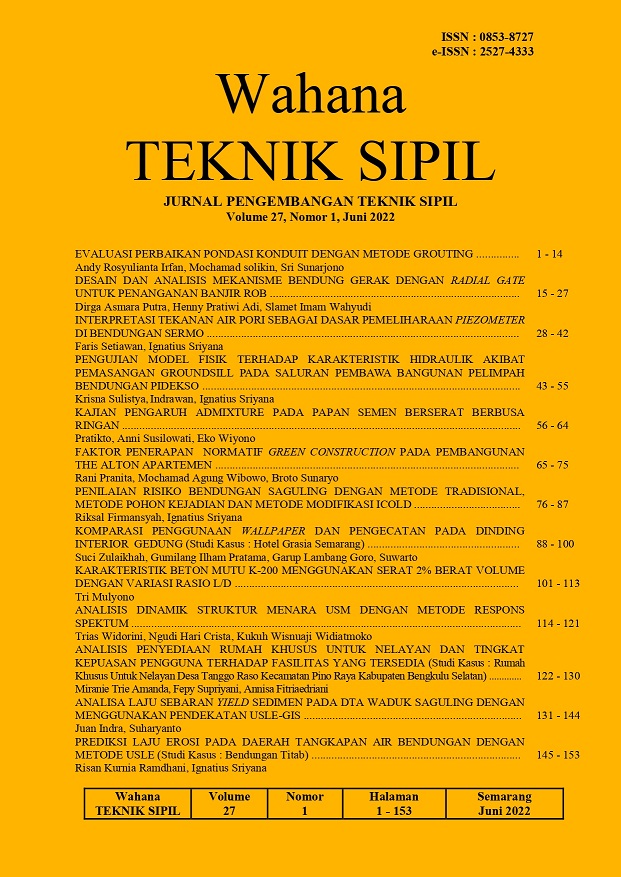ANALISIS DINAMIK STRUKTUR MENARA USM DENGAN METODE RESPONS SPEKTUM
DOI:
https://doi.org/10.32497/wahanats.v27i1.3676Keywords:
drift, base shear, response spectrum, dynamic analysisAbstract
The USM tower consists of 10 floors used as offices, parking and educational facilities with a total height of 48.5 m. Earthquake resistance analysis needs to be carried out on buildings built in earthquake areas. This study uses dynamic analysis with the response spectrum method, aiming to evaluate the structure according to SNI 1726:2012. What is reviewed in this study is the period, base shear, drift, and the level of building performance. The results of the analysis show that the period, base shear, drift and the maximum deviation meet the specified requirements. The USM Tower's performance level is Immediate Occupancy according to ATC-40 regulations.References
Afrida, I., Wahyuningtyas, W.T., & Krisnamurti, 2020, Analisis Ketahanan Gedung Apartemen Surabaya dengan Menggunakan Metode Respon Spektrum. Jurnal Berkala Sainstek, 8(4), 132-139.
Applied Technology Council, 1996, ATC-40 Seismic evaluation and retrofit of concrete buildings. California: SEISMIC SAFETY COMMISSION State of California.
Badan Standardisasi Nasional, 2012, Tata Cara Perencanaan Ketahanan Gempa untuk Struktur Bangunan Gedung dan Non Gedung, SNI 1726:2012.
Badan Standardisasi Nasional, 2013, Beban Minimum untuk Perencanaan Bangunan Gedung dan Struktur Lain, SNI 1727:2013. BSN.
Harahap, M.F., & Fauzan, M., 2019, Perilaku Dinamik pada Struktur Apartemen Metro Galaxy Park terhadap Beban Gempa. Jurnal Teknik Sipil dan Lingkungan, 4(3), 195-205.
Nur, A.M., 2010, Gempa Bumi, Tsunami dan Mitigasinya. Jurnal Geografi, 7(1), 66-73.
Pusat Studi Gempa Nasional, 2017, Peta Sumber dan Bahaya Gempa Indonesia Tahun 2017. Pusat Penelitian dan Pengembangan Perumahan dan Permukiman, BPP Kemen PUPR.
http://puskim.pu.go.id/Aplikasi/desain_spektra_indonesia_2011/
Downloads
Published
Issue
Section
License
Authors who publish with this journal agree to the following terms:Authors retain copyright and grant the journal right of first publication with the work simultaneously licensed under a Creative Commons Attribution License that allows others to share the work with an acknowledgement of the work's authorship and initial publication in this journal.
Authors are able to enter into separate, additional contractual arrangements for the non-exclusive distribution of the journal's published version of the work (e.g., post it to an institutional repository or publish it in a book), with an acknowledgement of its initial publication in this journal.
Authors are permitted and encouraged to post their work online (e.g., in institutional repositories or on their website) prior to and during the submission process, as it can lead to productive exchanges, as well as earlier and greater citation of published work (See The Effect of Open Access).






